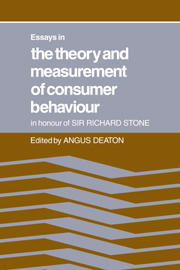Book contents
- Frontmatter
- Contents
- Foreword
- List of contributors
- Part one The analysis of commodity demands
- Part two The theory of index numbers
- Part three The consumption function and durable goods
- Part four Other aspects: fertility and labour supply
- Introduction
- 10 On labour supply and commodity demands
- 11 Child spacing and numbers: an empirical analysis
- Bibliography of Sir Richard Stone's works 1936–79
- Index of names
- Subject index
- Frontmatter
- Contents
- Foreword
- List of contributors
- Part one The analysis of commodity demands
- Part two The theory of index numbers
- Part three The consumption function and durable goods
- Part four Other aspects: fertility and labour supply
- Introduction
- 10 On labour supply and commodity demands
- 11 Child spacing and numbers: an empirical analysis
- Bibliography of Sir Richard Stone's works 1936–79
- Index of names
- Subject index
Summary
One of the most significant developments in economics over the past twenty years has been the increasing extent to which economists have been prepared to apply the basic tools of consumer theory to areas other than just the demand for goods. A particularly notable example is the analysis of labour supply, where utility theory has been successfully used in the empirical analysis of a wide range of phenomena, including the supply decisions of primary and secondary workers, the decision whether or not to participate, and the type of behaviour which results from the complex rules of modern tax and social security systems. For a discussion of this material see, e.g. Killingsworth (1981) or Deaton and Muellbauer (1980, chapter 11). More generally, the ‘characteristics’ or household production model has been applied to a wide variety of economic problems. Amongst the earliest examples is Gorman's famous 1956 paper on eggs, although it was Lancaster (1966a, b) whose work firmly established the methodology in the literature. In part one of this volume, the chapter by Theil and Laitinen can be interpreted as a characteristics model with the transformed goods as the characteristics, but much wider applications are possible. In particular, the model has been applied to the analysis of human capital formation, of fertility, of the use of time, of sexual and racial discrimination, of quality, and of health, to name only a few topics.
- Type
- Chapter
- Information
- Essays in the Theory and Measurement of Consumer Behaviour: In Honour of Sir Richard Stone , pp. 262 - 264Publisher: Cambridge University PressPrint publication year: 1981



